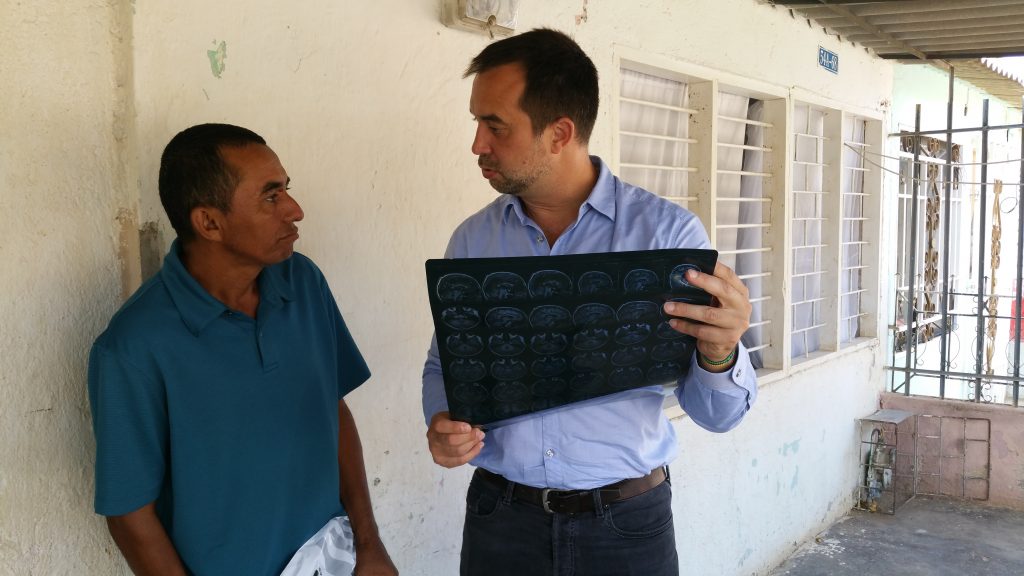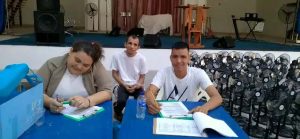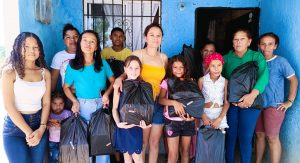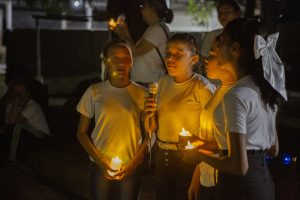When we finally got our flight to Bogota from Quibdo, it was late at night. the plane was delayed and we did not take off until after 9pm. we landed around 11pm and we had to be back at the airport at 8am for the flight to Santa Marta. At the beginning of the trip, we barely slept more than 4-5 hours a night.
In Santa Marta, we were greeted by our collaborator Mariela Campo, the President of Funcovulc (click here for their website), one of the local patient associations working in the Magdalena State, a province in Colombia that now holds the largest number of HD families. Its really hard to know just how many people there are affected by HD, as a proper census has never been conducted. Initially, the Juan de Acosta township in The Atlantico province was known as the second largest cluster in the world after Maracaibo, with an incidence of 4.3 per 1000 people affected, based on the work of neurologist Dr. Daza a few years back. However, due to discrimination and social neglect, many families from Juan de Acosta are thought to have left and have started to take wiht them HD to other parts of the country. We dont know if the hundreds of affected families in Magdalena State originated in Juan de Acosta or even are of Venezuelan descent. What we do know, however, is that every month new cases appear. The majority of families affected know by word of mouth that the patient associations want to help, so they get in touch with them. sometimes it is the associations who hear that someone here or there might have HD, and go to visit them. Not all families are confirmed HD families, as access to the test is difficult in these rural areas (no easy access to hospitals, no local neurologists, and no genetic counselors make this almost impossible). But it is suspected given the large family relationships in the area and the fact that some distant relatives have confirmed HD. In any case, Funcovulc has almost 600 families registered. only a fraction of those are known to government or medical institutions.
Santa Marta is in the Atlantico province, in the Caribbean sea, and is a city full of music and palm trees. Santa Marta became our base for the next 48 hours, and we drove from there south to Sabanas de San Angel, one of poorest and more isolated places in Colombia. I had been there in 2013 and was shocked by the conditions of the families.This time around, it would not be any different. We left at 4am with a car packed with food, toys for the children and other things the families needed. Altogether, we visited 13 families and brought with us more than food and toys- we brought them information and a message of love and care. This day was probably one of the most significant days for me in my life. In spite of the misery and struggle, I felt alive and at peace with myself and the world. I was here to help. I was here to bring them a smile. and I saw many that day, and smiles in the faces of the children that i will never forget. Sometimes we undervalue how much a hug, a kiss and a smile can do for a person in need.

The Sabanas de San Angel is an area devoid of any infrastructure, people live without fresh water, and many families lack electricity. Their houses, built from wood planks that don’t fit well, have dirt floors, and currogated steel roofs that magnify the terrible heat in the long summer months. When it rains, the water leaks through the gaps and wholes found everywhere on the roof and walls of the house, and the houses flood. This is a real issue for HD families, as most do not have any furniture, and the patients lie on matts on the floor, or sleep in hammocks. As the houses flood, it becomes a real problem where to place the patients. This is real misery and talking to these families brings a strong sense of dispair, almost anger, at how abandoned they are.
How can we let sick people die in this kind of environment, without ever seeing a doctor, without food to eat, and no sanitation?
The San Angel region has become an epicenter for my social work. I will not leave them alone to die in oblivion.


These pictures below are from a family living in extreme poverty. The wife takes care of her dying husband and her son, who suffers from juvenile HD. Her husband spends his days tied to a bed. He has been suffering with HD for 14 years. He has never been seen by a doctor. His body is emaciated, all bones and flesh. Here, his wife feeds him what she can. They have 2 kids together. Their daughter is unaffected and has a 2 year old daughter. Their son started having symptoms at 17. He is now 24 and can’t speak any more. In spite of his rigidity, he goes to sell the 1 liter of milk they can obtain from their one cow. With that money, they can buy some food. Together with them, a 10 year old kid lives wiht them as well. He did not have any shoes and walked to school bare footed for an hour each way. I decided to sponsor him and bought him shoes and clothes after i left. It is while visiting this family that 2 projects emerged – the ‘Project Abrazos’ in which we are sponsoring 30 children living in HD families; and a project to build fresh water wells for the poorest of families. With water, they will grow vegetables for food and will have grass to feed their cows.





We went around family to family bringing a variety of things they need – mostly food, clothes, sometimes hammocks and even a fan for one of the families who steals electricity from the street light close by. There are some wealthier neighbors (who own the land), so they can sometimes, with ingenuity, tap into electricity. I also brought from the USA a suitcase filled with toys for the kids… stuffed animals, pencils, crayons, metal cars, marbles and candy. Their smiles made me temporarily forget what i was witnessing.





The landscape in San Angel is also hauntingly beautiful in spite of the drought. In certain areas, yellow-leaves Cañahuete trees brightened the dry soil under the blue skies. It was a sight to see. The trees are magnificent here and I can only imagine when the rain comes how beautiful the landscape becomes.

We left San Angel and delivered more donations to other families in the area, and even visited some of the people I had met last time I was here in 2013. Slowly, we are building long-lasting relationships with these families. some of them remembered me, and we talked about their lives, my hopes, and their children. after 10 pm we finally made it back to Santa Marta- it had been a day filled with emotions, and the beer we had when we got back to the hotel was one of the best beers i have ever had! Dara and I enjoyed ourselves in the midst of the music and the drinks at the bars – tourists and locals oblivious to the reality that permeates this land, just a few miles away in the country side. Such is life.

The second day, we continued to visit some families and also we met with officials at the local secretary of health. There we begun to understand part of the problem. No one really wants to deal with these patients. They dont have the knowledge and lack any interest to help. We heard worrysome comments like ‘everyone including all the kids should be forcibly tested- so that the government can know where they are and ensure they do not have any more kids’. This is not news in many of these places – eugenic tendencies abound, and their rights must be carefully protected. There is a lot we can do to educate the institutions. These statements are not just words – we found out that in San Angel, last year, government officials came unannounced and tested everyone in many of the families we visited. Including children and infants. These government workers came from the National Institutes of Health, entered data in the computers, told them they would deliver the test results (which they knew they cannot do) and left. They never heard from them again. These types if issues one only finds out when visiting- and these are important facts that help us develop a plan of action to ensure national and local institutions understand the rights of these families and act to protect them, rather than violate them.







